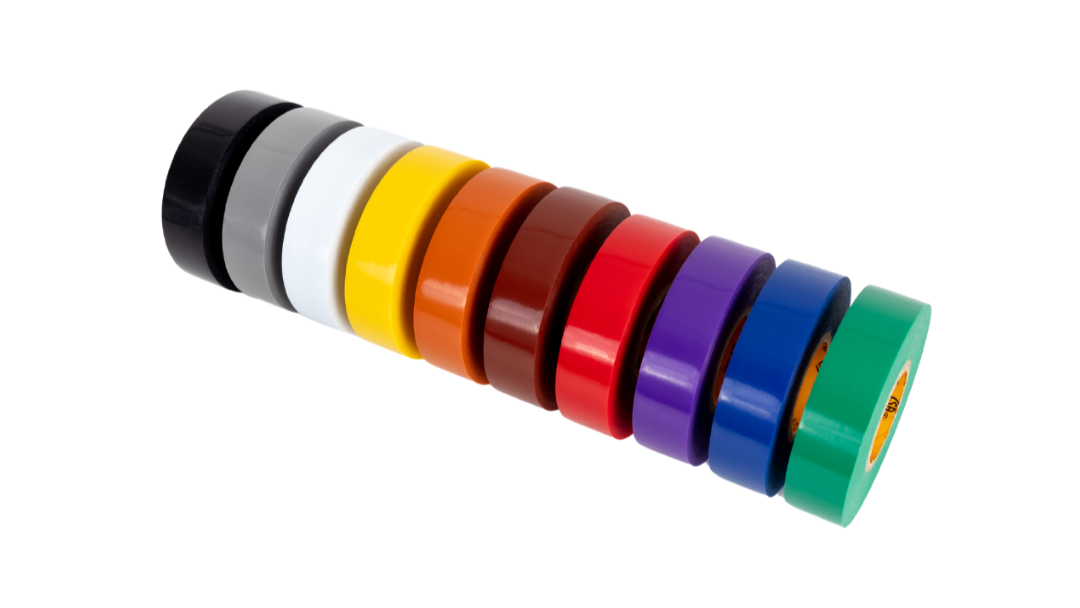A Comprehensive Guide to PVC Electrical Tape
Posted by Tom on 24th Aug 2021
Electrical tape is used in many settings, from electrical installations and commercial wiring projects, as well as for home DIY.
It is used for cable management, and for insulating and repairing damaged wires. There are so many types and colours of electrical insulation tape available, it’s important to understand which purposes they are meant to be used for.

What is electrical tape and what is it used for?
Electrical tape is used to insulate electrical wires which conduct electricity. It is usually made from PVC (a type of plastic), because of its excellent elasticity and insulating properties. It stops electricity conducting from one wire to another, which could potentially cause a fire. It also is used to prevent electrocution from touching live wires.
Electrical tape is mainly used by electricians to:
- Insulate wires, cables, connections and connectors to stop them conducting electricity
- Make repairs to damaged cable sheathing
- Bundle and wrap cables together
- Seal and mark cables for identification
When was electrical tape invented?
Almost 80 years ago, 3M inventors Snell, Oace, and Eastwold created vinyl electrical tape in the US. Up until then, electricians were using unreliable and weak tape made of cotton. 3M’s first vinyl electrical tape was patented in 1946 and was originally white or yellow in colour.
What do the different colours of PVC electrical tape mean?
Every colour of electrical tape has a purpose. Black tape is used generally just for insulation, while other colours are used for showing the voltage level and phase of wires.
This electrical insulation tape colour chart guide explains the standard use of each colour in the UK and internationally:
| Usage | ||
| UK | International | |
| Red | Low voltage, phase A | Sheath, 415 V 3 phase |
| Black | Insulation/low voltage, neutral | Low voltage phase B |
| Yellow | Low voltage, phase B | Sheath, 110 V Site wiring |
| Green | Earth | |
| Brown | Low voltage phase A | |
| Grey | Low voltage, phase C | |
| Blue | Low voltage, phase C | Low voltage, neutral Sheath, 230 V |
| White | External applications involving white cordage | |
| Green and yellow stripe | Earth | |
White, grey, brown, and green and yellow striped tape are not as commonly used in the UK as they are elsewhere in the world, so there are no standard UK usages for these colour tapes.
UK safety guidelines
The Health and Safety Executive lists the commonly used electrical standards and codes of practice in the UK. When working with wires and electrical equipment, preventing electric shock and maintaining fire safety are the most important priorities.
All electrical insulation tape manufactured and used in the UK must comply with BS EN 60454-2 and BS 4J10:1991 standards. These standards specify the tests that electrical tape has to pass to be manufactured and sold. These tests mainly focus on fire safety and heat resistance.
Image: paid, from Shutterstock
H2: What are the features and technical information of PVC electrical tape?
PVC electrical tape is flexible, with excellent protection against abrasion. It’s also moisture and UV resistant, as well as flame retardant. It’s suitable for both indoor and outdoor use.
The different properties of electrical tape include material, thickness, elongation, tensile strength, adhesive ability, dielectric strength, temperature rating and flame retardancy.
H3: Technical information of GTSE electrical tape
- Material: Premium grade plasticised PVC film
- Total thickness: 0.15mm (±0.02)
- Elongation: 125%
- Tensile Strength: 22 N/10mm
- Adhesion: Rubber based
- Adhesion to steel: 2.5N/10mm
- Adhesion to self: 2.5N/10mm
- Dielectric Strength: 40 kV/mm
- Temperature Rating: -18°C to +105°C
- Flame Retardancy: Self extinguishing
Can electrical tape catch fire?
If electrical tape is used properly, it is highly unlikely it will catch fire, but it is not entirely impossible. It is designed to be flame retardant and self-extinguishing.
Can electrical tape withstand heat?
Our PVC electrical tape is designed to withstand heat up to 105°C.
How stretchy is electrical tape?
Electrical tape is very stretchy. Its stretchiness is measured by ‘elongation’. Elongation is how far the tape will stretch from its original length, while keeping its integrity and not breaking.
Is electrical tape waterproof?
PVC electrical tape is not waterproof, but it is designed to be water and humidity resistant to a certain degree.
How strong is electrical tape?
Tensile strength is how the strength of electrical tape is quantified. GTSE electrical tape has a tensile strength of 22 N/10mm. There is also its dielectric strength, which is explained below.
Can electrical tape conduct electricity?
No, electrical tape does not conduct electricity. The dielectric strength of tape is a measure of how much electric field it is able to sustain before its insulating properties begin to fail. Our tape has a dielectric strength of 40 kV/mm.
Can I use duct tape instead of electrical tape?
Duct tape should not be used instead of electrical tape if you’re working with wires. This is because duct tape is not designed to be used when working with electrics. Duct tape is also difficult to remove and not as stretchy as electrical tape.
How to remove electrical tape residue
To remove electrical tape residue, firstly, make sure the item is disconnected from electricity. Use hot soapy water, WD40 or rubbing alcohol and a cloth or brush to remove the remnants of the tape.
Where to buy electrical tape
We stock a wide range of low cost PVC electrical insulation tape, available to buy in bulk.
Buy GTSE cable management accessories
We also sell accessories that you can use with electrical tape. See our cable management solutions, terminals and connectors.


